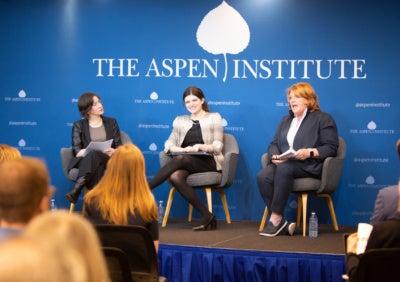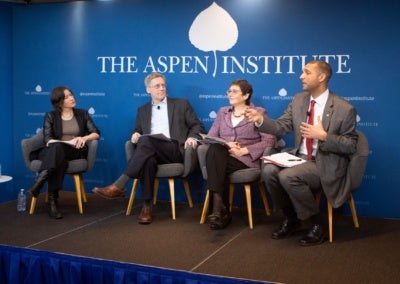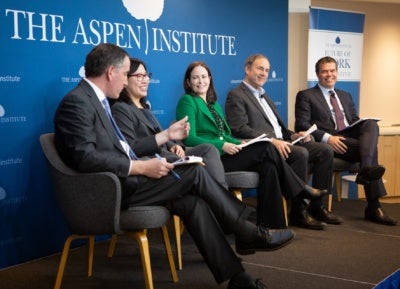Last week, the Future of Work Initiative hosted an event in Washington, DC to discuss how automation is impacting the labor market, the challenges and opportunities it presents, and potential policy solutions for a rapidly evolving 21st century economy. The event, supported by the Autodesk Foundation, was hosted in conjunction with the release of the Initiative’s new report, Automation and a Changing Economy.
Lauren Weber of the Wall Street Journal began the event by moderating a discussion with Congresswoman Haley Stevens of Michigan and former Senator Heidi Heitkamp of North Dakota, who currently serves as a Visiting Fellow at the Harvard Kennedy School’s Institute of Politics. Their conversation highlighted the role of policymakers in addressing the challenges of automation and guiding workers through the changing nature of work.
Next, a panel of experts explored what is known about how automation impacts the economic security of American workers. This panel, also moderated by Lauren Weber, included Erica Groshen of the Cornell ILR School and Upjohn Institute for Employment Research, Mark Muro of the Brookings Institution’s Metropolitan Policy Program, and Spencer Overton of the Joint Center for Political and Economic Studies.
The final panel, moderated by Future of Work Initiative Executive Director Alastair Fitzpayne, examined potential solutions to the challenges presented by automation, featuring Jon Hiatt of the Solidarity Center and the Berkeley Labor Center, Scott Rutherford of McKinsey & Company, Kristen Silverberg of Business Roundtable, and Portia Wu of Microsoft.
From the panel discussions, we would like to highlight four key takeaways:
1. Ensuring that the gains from automation are broadly shared will require prioritization across sectors.
Rising to the challenge of preparing the workforce for the future requires a sense of urgency from government and business alike. Mark Muro made the case for action by sharing that “the pace of disruption seems already to be challenging individuals’ and society’s ability to respond—let alone Congress.”
Policymakers have responded with an expressed interest in solutions that support workers and communities adjusting to automation. Congresswoman Haley Stevens, who represents Michigan’s 11th District, pointed to changes that have taken place in the area, which just 10 years ago experienced the “largest drop in automotive sales in the history of the automobile,” leading to double digit employment. The Congresswoman mentioned that her district is currently “responsible for 75 percent of the R&D in autonomous vehicle technology.” This shift has presented an opportunity to lead by utilizing the existing human capital and talent in the region. Congresswoman Stevens noted, “If public policymakers are going to play a role—which we intend to—in this future of work conversation, we [must be] placing a value on the work, and saying that your role matters. We have to start talking about a 21st century labor movement.”
 Senator Heitkamp shared the sentiment that the government has a responsibility to ensure that workers have the opportunity to benefit from technological change. “If we want economic growth, if we want trade policies that make sense, if we want automation that makes sense,” Senator Heitkamp expressed, “then we’ve got to explain and be willing to do everything that we can to ensure American workers benefit as a result.”
Senator Heitkamp shared the sentiment that the government has a responsibility to ensure that workers have the opportunity to benefit from technological change. “If we want economic growth, if we want trade policies that make sense, if we want automation that makes sense,” Senator Heitkamp expressed, “then we’ve got to explain and be willing to do everything that we can to ensure American workers benefit as a result.”
Employers also have a responsibility to think critically about how to adopt new technologies and ensure they are not leaving workers behind in the process. As Scott Rutherford from McKinsey noted, “There are a lot of major employers across the globe and in the United States that are taking this quite seriously, changing the way that they are doing workforce planning, changing the way that they actually adopt technology and the time frames that they do it.”
2. Coordinated efforts and partnerships are critical to creating positive outcomes for workers.
To ensure that workers are prepared for potential transitions resulting from increased automation, stakeholders need to work together in a coordinated effort. Speakers agreed that it is not the responsibility of one sector alone, but rather, of many stakeholders—employers, workers, government, labor, non-profits, and researchers—to develop solutions.
In thinking about matching skills to local needs, Kristen Silverberg mentioned that Business Roundtable has “worked to bring together employers, unions, educational institutions, providers, and the entire ecosystem to understand—on a very local level—what jobs are likely to be available and what skills they’ll require,” through their Workforce Partnership Initiative.
Regarding education and training programs, Senator Heitkamp noted that historically, “there has not been the appropriate level of collaboration between state and local entities, business entities and the federal government.” When it comes to specific policies, Senator Heitkamp encouraged “a major focus on centralizing workforce development and training within the federal government,” and highlighted the need in a variety of sectors for “a unified program to train the trainers.” She explained that welding professionals in North Dakota have the potential to earn $150,000 each year but welding trainers earn far less, effectively disincentivizing successful welders from shifting into the training space.
3. The discussion about preparing workers for the future must include broad stakeholder representation.
In order to help workers benefit from automation, a wide range of organizations, including worker advocates, need to have a seat at the table when discussing solutions to disruption. Some specific demographic groups and communities are likely to experience higher levels of automation in their work, and policymakers should understand these impacts and develop solutions accordingly.
 Spencer Overton pointed to a Joint Center study that found 31 percent of Latino workers and 27 percent of African American workers are concentrated in 30 jobs at high risk to automation. Overton noted that changes in the economy present an opportunity to “use disruption to be inclusive and to advance equality, as opposed to sitting back and letting inequality come.” From a community perspective, Mark Muro shared that in general, “places with lower education levels, heavy histories of manufacturing, and routine service jobs got hit first over last 40 years and they have highest exposure levels now.”
Spencer Overton pointed to a Joint Center study that found 31 percent of Latino workers and 27 percent of African American workers are concentrated in 30 jobs at high risk to automation. Overton noted that changes in the economy present an opportunity to “use disruption to be inclusive and to advance equality, as opposed to sitting back and letting inequality come.” From a community perspective, Mark Muro shared that in general, “places with lower education levels, heavy histories of manufacturing, and routine service jobs got hit first over last 40 years and they have highest exposure levels now.”
States and businesses must consider the rights of workers and how to best position the workforce to take advantage of the opportunities that automation will present. As one idea, Jon Hiatt suggested that states, education providers, and business “develop a standard and model worker rights curriculum that we could attach to training programs.” He said such a program “would help put workers in the role of being a responsible player and figuring out how to bring new technology into the workplace.”
Automation will also vary across different types of businesses. Panelists highlighted that organizations of different sizes and structures need to be part of the conversation. For example, smaller businesses may lack some of the resources to recruit, manage, and train workers, as compared to larger corporations. Portia Wu noted that “it is important to have many voices at the table…sometimes that [small] business owner doesn’t know what the next technological trend is.” There may be a role for firms developing new and emerging technologies to play in helping share information on where technology is headed.
4. We need better data to understand what is happening and how to plan for the future.
Preparing for the impact of automation requires good data. Historically, the government has done little to track technological trends and how these trends impact work. While many private entities have the ability to collect large quantities of information on automation and the workforce, it is not always effectively shared with the public or the organizations that could benefit from such knowledge.
According to Erica Groshen, former Commissioner at the U.S. Bureau of Labor Statistics (BLS), “We need good data for tracking national and local job dynamics and training, for forecasting what’s coming, and supporting program evaluation.” How could data be improved? Groshen suggested that the BLS could start with the Survey on Employer-Provided Training, which was last conducted in 1995, or could use administrative data, like the jobs and earnings information already tracked through the Unemployment Insurance system. She went on to suggest that the government could also take advantage of new technologies, like artificial intelligence, to analyze data and improve forecasts.
 Additionally, improved data on skills could allow training providers to develop more effective programs. While the government gathers a significant amount of data on skills needs and student records, Portia Wu—who previously served as Assistant Secretary of the Employment and Training Administration at the U.S. Department of Labor—shared that the U.S. needs a better system for sharing these data. This information can be used to create programs that are better tailored to the needs of a diverse population. Spencer Overton shared, “We need better skills data with regard to training and demographics in terms of skills. The same training program may not work well for everyone, and we don’t want to design a training program that meets one group.”
Additionally, improved data on skills could allow training providers to develop more effective programs. While the government gathers a significant amount of data on skills needs and student records, Portia Wu—who previously served as Assistant Secretary of the Employment and Training Administration at the U.S. Department of Labor—shared that the U.S. needs a better system for sharing these data. This information can be used to create programs that are better tailored to the needs of a diverse population. Spencer Overton shared, “We need better skills data with regard to training and demographics in terms of skills. The same training program may not work well for everyone, and we don’t want to design a training program that meets one group.”
Looking ahead
While we need better data to understand how automation and emerging technologies are impacting work, there are concrete steps we can take today to plan for the future. We hope this event helps advance the conversation around how automation can lead to broad prosperity for workers, and we look forward to translating ideas to action. We encourage you to read the Future of Work Initiative’s recent report, which shares 22 specific proposals to address the opportunities and challenges of automation and help workers and businesses adapt and succeed in this changing economy.

